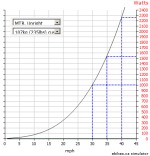You say you "can hit 36mph' and want to go 40mph". Does that mean in a tuck and in perfect conditions the bike will get to 36mph flat out? Do you want to "hit 40mph" the same way or actually have a 40mph bike that will do 40mph for extended periods without riding like a pretzel or having the motor melt? Briefly achieving 40mph in a sprint in perfect conditions is a whole different thing from the perspective of component selection -- although the power requirements are the same as sustained speed.
There's certainly no shortage of things you can try to boost your top speed, but here's some results from the simulator to put things in perspective.
Here's a plot showing a MTB in normal riding position for a 235lb load as mentioned above. This shows the power you need to get to the road - not the power your battery must supply (divide the watts shown here by about 0.80 or 0.85 overall system efficiency for that). For example, you need to get an extra 700W to the road to increase speed from 35mph to 40mph (about 700W/0.85 = 835W of extra battery power). Or looking at it a different way, from 35mph you need to add an extra 700W/1530W = 45% power to make it to 40mph --
half again as much to go 5mph faster as it took to get to 35 in the first place. That's the shocker...

That plot shows the basic problem of aero drag pretty graphically - you need huge power increments to go just a few miles an hour faster once you get past 25mph or so.
To show the effects of aero drag comparatively, here's the identical setup on a MTB in a tuck position. Here you can see the dramatic reduction in required power to achieve the same speeds as in the first plot (e.g. only 1600W instead of 2250W to hit 40mph). If you "are hitting 36mph" in a tuck, this is the plot that shows the power you are delivering to the road - not the first plot. However, at these speeds we see that you still need to add about 500W/1100W = 45% more power to get to 40mph from 35mph.

As was posted above, without instrumentation (wattmeter/ammeter) or other specifics we don't really know if the motor Kv (wind) or controller is limiting your speed, but the whole power thing is quite likely if your components are anywhere near matched. ( Spending a few bucks to measure what's going on and evaluate improvements is a good plan.)
Again, these simple plots are just the standard "bike computer" part of the simulator (all physics - no simulation) and have nothing to do with the particulars of the motor, wheel size, controller, or battery - these show the very best you can ever achieve with an optimal selection of components. If your battery can deliver the necessary power, you can look at changing/selecting parts to get closer to these performance points but you can never use less power than shown here (physics can be really annoying...).
So - I'm not trying to discourage your efforts to improve the bike which is always a fun thing to do, but you may need to temper your expectations so that your efforts can actually meet with success. You can do things to squeeze out a bit more speed, get better acceleration, climb hills a little better, or get a more comfortable posture but big steps into the sustained high speed club require that you ante up some bucks for better parts and perhaps make motor/wheel mods as well.



